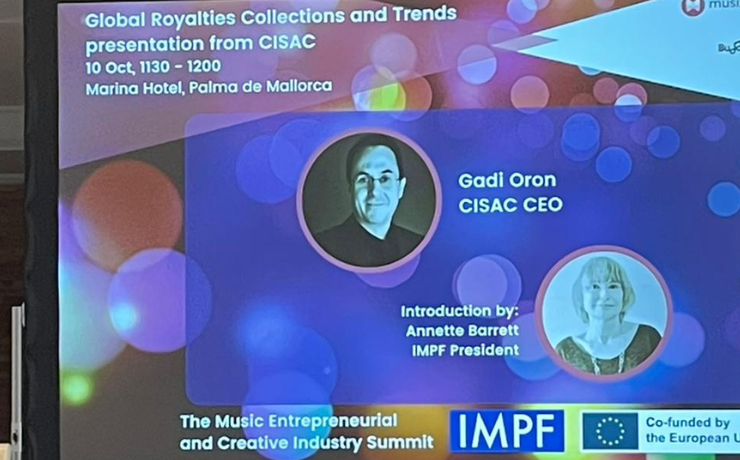“Our mission is to bring creators and rightsholders more value from digital”

Increasing royalty collections for music creators is the top priority guiding CISAC’s work in the coming years, CISAC Director General Gadi Oron told a conference of independent music publishers and creators.
In a keynote speech on trends in global collections, Oron said CISAC’s upcoming Global Collections Report will show 2021 global collections back to growth after the worst of the pandemic. However, the recovery is not complete, and the challenge ahead is to maximise royalties from digital use to drive future growth.
The Report, providing comprehensive data and analysis on royalty collections, will be published by CISAC on October 27th.
The CISAC DG was speaking at the Music Entrepreneurial and Creative Industry Summit, organised by the Independent Publishers Association IMPF, which took place from 9-12 October in Palma de Mallorca, Spain and was attended by more than 200 delegates.
He said the pandemic had disrupted the traditional long-term upward trend in royalties collected by CISAC societies across the world.
“If we zoom out and look at the overall figures, until the pandemic, it is fair to say that authors rights royalties have shown - historically - a steady, solid, and reliable growth.”
“But for 2020, for all repertoires put together, we reported a decline of 10% compared with the previous year (2019). This meant that in terms of the level of collections, the pandemic sent us 5 years back, to what we collected in 2015."
“We feared it would be much worse. At some point in 2020 we expected a 30% drop. Thankfully that wasn’t the case, because digital income helped to offset the decline of sectors, mainly live concerts and public performance.”
“The good news is that in 2021 we have returned to growth. And, bearing in mind that in 2021, the live and public performance sectors remained largely dormant, that return to growth in 2021 is an impressive achievement.”
Oron underlined the vital importance of digital royalties to the prospect of future growth in creators’ collections. Improving the technical infrastructure underlying royalties collections from streaming platforms will help further accelerate digital growth.
“Successful digital collections depend on efficient flows of data between all parties in the ecosystem – creators, publishers, societies, and DSPs.
And CISAC plays a key role here because we are the administrator of the music works identifier ISWC.”
The ISWC is the international standard for musical works codes, administered by CISAC. “When a song is released, it is typically uploaded to digital service providers such as Spotify only with the ISRC codes, the recording industry’s identifier. But the ISRC only identifies the recording, not the composition. The ISRC codes do not say who the creators are. That’s the role of the ISWC. It is therefore crucial to implement the ISWC throughout the value chain by all parties – including digital platforms.
Oron outlined CISAC’s recent modernisation of the ISWC to make the system work more accurately and efficiently.
“In the past 2 years we’ve delivered projects to improve the services that we offer around the ISWC. We did this to make the process and data flows more efficient, and to promote greater implementation of the ISWC codes throughout the value chain. There is one key goal here, which is to establish the ISWC as an accurate and reliable identifier that is used across all parts of the music industry.”
But in addition to upgrading the system, there needs to be a concerted effort to have the ISWC adopted across the value chain, Oron said.
“Getting the ISWC to work better across the ecosystem will benefit everyone - and most of all, songwriters, and composers. It will help grow digital collections and it will help all of us to recover more quickly from the decline that the pandemic forced on us.”
“Now is a good moment to pick up the momentum and get implementation back on track.”
“It’s in everyone’s interest. The technology is there. The services are there. And the key to increasing digital collections even more, is to use them.”
Note: the CISAC Global Collections Report will be published on October 27th 2022